|
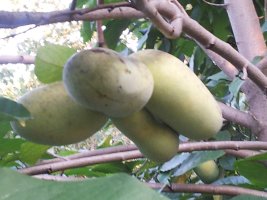

The fruit of premium pawpaw seed
Known as the woods banana, medium to large fruit. Pawpaw is sweet, with tropical flavors, and is North America's largest native fruit.
We can supply and select cultivars that will have a 95% chance of being as large or larger than the parent fruit producer. We offer these seed at a premium price because of the extra work it takes to produce such seeds: controlled crossing and the necessary documentation and care of records.
These Seed represent The Best PAWPAW Genetic Material in the world and will be available until sold out.
Fresh shipped now or Spring. All Spring shipped seeds will be stratified.
CLICK HERE for pawpaw seed germination instructions
| Shipping cost of pawpaw seed: |
|
One pound of seed equals 300 to 350 seed per pound depending on seed size. There is a direct correlation between the size of the seed and the size of its fruit. The bigger the fruit the larger the seed.
NOTE: The pawpaw seeds described below do not include prices like you see next to trees for sale on other pages of this website. That is because they are strains of seed used to breed our unique premium pawpaw seed. Instead, you will see a separate table with prices next to seeds whose parentage is indicated. You may refer back to descriptions of the parents to see if the seed will have the characteristics you are looking for.
Identified Strains of Hand Bred Pawpaw Seed
See below descriptions for seed availability
Brief descriptions of the Jerry Lehman pawpaws:These are the best of over 500 hand bred specimens from named varieties. Trees with poor characteristics have been removed from his orchard. Flavor overtones vary, Lehman does not try to detail flavors as they are subjective.
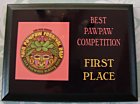
Maria’s Joy (cv 166-13) - A Davis X Prolific cross. Produces good crops annually, average 8 to 14 oz range, as high as 16. All visitors to Jerry’s orchard love this cultivar. A well known fruit author remarked it was the best tasting pawpaw he ever tasted. Won the Ohio Pawpaw Festival’s "Biggest Pawpaw Contest" in 2012. Fruits 631 to 704 gm.
Sam Norris 7 (SN-7) -Mr. Norris used colchicine to develop tetraploids. Seed ploidy is unknown.
VE-9 Prolific X Overleese - Average to large fruits. Late ripening, sweet, excellent flavor.
VE-21 Prolific X Overleese - Variety is very early, produces pawpaw that range in size from average to large, light yellow skin, and has a sweet, excellent pawpaw flavor.
166-20 A Davis X Prolific - Produces small to average size fruits however very sweet and a pleasingly yellow skin making it easier to determine if nearly ripe.
166-66 A Davis X Prolific - Produces small to average size fruits however very sweet and a pleasingly yellow skin making it easier to determine if nearly ripe. A open pollinated seedling of Davis X Prolific. The pollen parent is likely Davis X Prolific. Due to its location the pollen parent of these seeds is likely another Davis X Prolific cross. Therefore these seeds are likely inbred, but inbreeding depression doesn't seem to be a problem in Asimina triloba, pawpaw. 166-66 is one of the first to drop above average size fruits, green/yellow when ripe, sweet, excellent taste.
| Plaques awarded: 250-30 | 250-39 |
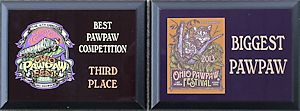 |
 |
250-30 Open pollinated seedling of KY-8-2. Won the biggest pawpaw contest in 2013, 680 gr. (1.5lb) and placed third in the best pawpaw contest 2014. Great flavor, sweet.
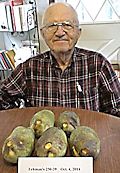
250-39 A cross of Sunflower x Sam Norris-15. This cv consistently produces
the highest percentage of huge fruit. In addition to many large fruits (10 to 14
oz., 283 to 395 gr.) this tree produced 10 weighing over 1 pound. Mid-season
too late. Flavor is good example of why pawpaws are called Indiana Banana.
1st Place winner of the Best Pawpaw tasting Contest at the Ohio pawpaw Festival 2013 and 2017 and winner Biggest Pawpaw Contest 2014.
To the right is Lehman with five fruits from one pedicel, each over 455 gr. (1 lb.)
275-48 A cross of Prolific X Sam Norris-15. Won the Ohio pawpaw Festival’s biggest pawpaw contest in 2011 and 2012. Additionally won second place in the best pawpaw contest in 2013 and 2014 beating out 14 other entries each year. Mid to late season excellent sweet flavor.
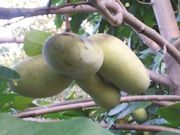
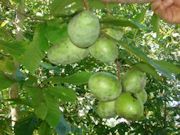
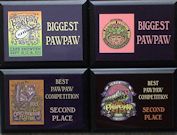
275-50 A cross of prolific X Sam Norris-15. Average large size, proven pollinator for 274-48.
275-69 Second place winner in the Best Pawpaw Contest at the 4th International Pawpaw Conference, Frankfort Kentucky, 2016. Bred by Jerry Lehman. Fruits - average size, butter smooth flesh, sweet, top of the line pawpaw flavor, light yellow skin when ripe making it easier to determine stage of ripeness when picking fruit.
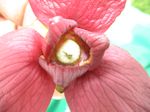
400-50 A hybrid of A. triloba x A. incarna bred by Lester Davis, Columbus GA. Open pollinated. Large flowers opening tubular, light green changing to purple and to red, up to 4 cm. Small fruit, inedible. Beautiful landscape small tree. Zone 5.
Quantities and prices of seed from our 2025 hybridizing efforts and crop
|
|
|
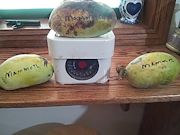 3 Mammoths |
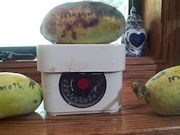 Mammoth on Scale |
Additional information: Breeding goals
VE-21 X 250-39 and VE-21 X 275-48 Combining the huge fruit size of the 250-39 or 275-48 with the very early fruiting attributes of the VE-21 to produce trees that should ripen in cooler climates with a larger than normal fruit size. Goal, a winner for size, flavor and earliness.
166-20 X 275-48 166-20 is small to average size, very sweet, and has good flavor. This variety produces a light yellow skin when ripe and is very attractive. The goal is to combine large size of 275-48 fruit with 166-20's attractive light yellow skin. This would make an excellent farm market fruit with good eye appeal.
250-39 X 275-48 Seed parent is gigantic, some weighting in over 1.5 pound. Fruit size can only be attributed to the influence of the second parent generational cross for the huge size of the fruit. The breeding goal is progeny that will bear large fruits as both parents produce large fruits. The fruits of both are delicious and sweet. These offspring have exceptional genes to develop from.
275-48 X 250-39 The seed and pollen parents are reversed of 250-39 X 275-48 (above). The Genetics are there and seedlings of this cross should produce many fruit weighting in at 450 plus grams per fruit on a regular basis. Flavor and sweetness should be among the best.
NC-1 X 250-39 By controlled pollination - Both parents excel in fruit quality and taste. The goal is combining with the 250-39 huge fruit bearing characteristic.
Lehman's Breeder Select Seed - These select seeds are from the famous pawpaws of the breeder in Terre Haute, Indiana. They are from the 2016 crop and are a mix of varieties that have been bred over the past decade in Jerry Lehman's orchard. These are not specific to a single variety.
Information:
Seed Stratified or Fresh Shipped, now or spring. All spring shipped seeds will be stratified.
1 pound of seed equals 300 to 350 seed per pound depending on seed size. There is a direct correlation between the size of the seed and the size of its fruit. The bigger the fruit the larger the seed.
All seed germination is subject to the care of the handler and not guaranteed or expressed in any way. These are the same seed we use and work with and, given the appropriate care, will make extraordinary plants and fruit producers.

